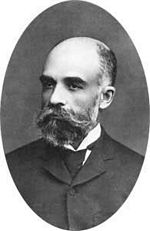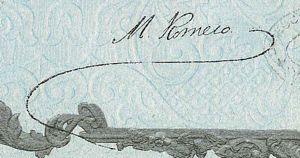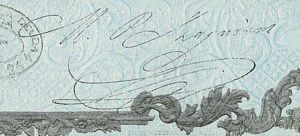Amortisation of the copper coinage
There were at least two series of bonds for the amortisation of Chihuahua's copper coinage.
Governor José Eligio Muñoz's bonds of 1860
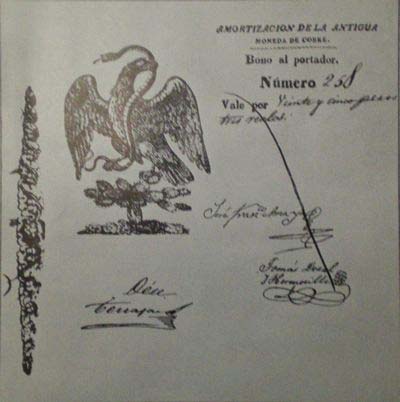
Bond 258 for $25.37 ½ , signed by José Francisco Anaya and Tomás Dozal y Hermosillo and countersigned by Terrazas (20cm x 20.5cm)
Firstly, on 20 January 1860 Governor Muñoz ordered the minting of a new issue of copper coinage and the amortisation of the existing coinage which, because of its poor quality, was easily counterfeitedDiscurso of Governor Muñoz, 8 April 1860. The holders of the old coinage were offered bonds and by 1861 more than 100,000 pesos was owed to owners of bondsDiscurso of Governor Terrazas, 18 September 1861. They still appear in the accounts of the Administración General de Rentas in 1866.
| José Francisco Anaya |  |
| Tomás Dozal y Hermosillo |  |
Certificados para la amortización de la moneda de cobre en el Estado de Chihuahua
Then, during the war against the French both President Juárez, on behalf of the government, and Governor Terrazas, on behalf of the state, authorised the minting of copper coins at the Chihuahuan mintPeriódico Oficial, 27 December 1860. These coins were extremely unpopular, being not accepted outside the state and with difficulty within. By 1868 they had depreciated by 70% and in May of that year the central government agreed to the use of federal receipts for their amortisationLa Republica, 7 August 1868. This decision caused alarm in Chihuahua and a rise in the price of bare necessities, so Terrazas suggested levying a forced loan of $100,000 to retire the remaining coins[A ], letter of Terrazas, 28 August 1868.
Juan N. Zubirán went to consult with the Secretario de Hacienda in Mexico City, and on 20 August 1868 the President approved the project for amortisation. On 18 September Governor Feliciano Ruíz, in accordance with the 20 August decree, appointed Esteban Benítez president of the Junta Central de Amortizacion, composed of Domingo Leguinazábal, Juan Mandrí, José Félix Maceyra, Jorge Macmanus, Jesús Mariñelarena, Manuel de Herrera, Francisco Espinoza, Sr., and Agustín HinojosLa República, 10 October 1868. As Benítez did not accept the appointment, José Félix Maceyra was named in his place and Antonio Asúnsolo added as a delegate. The junta met the next day, and apportioned the following contribution on each canton.
| Iturbide | $23,000.00 |
| Hidalgo | 22,000.00 |
| Mina | 8,000.00 |
| Rosales | 3,000.00 |
| Meoqui | 4,500.00 |
| Rayón | 3,500.00 |
| Allende | 7,000.00 |
| Guerrero | 2,500.00 |
| Bravos | 2,000.00 |
| Matamoros | 5,500.00 |
| Jimenez | 1,500.00 |
| Victoria | 3,000.00 |
| Abasolo | 2,000.00 |
| Galeana | 1,000.00 |
| Aldama | 1,000.00 |
| Camargo | 8,500.00 |
| Balleza | 2,000.00 |
| Total | $100,000.00 |
The list missed out the canton of Arteaga. On 23 September governor Ruíz asked for the reason.
On 9 October Terrazas published the provisional regulations that would effect the amortisation. The central Junta, headed by José Félix Maceyra, would issue provisional receipts and a junta of businessmen would oversee the destruction of the coins.
The government of the state of Chihuahua agreed that the certificates would be printed by the Tesorería General de la Nación in Mexico City and sent to Chihuahua. The bonds were issued in a series of six values dated 31 October 1868.
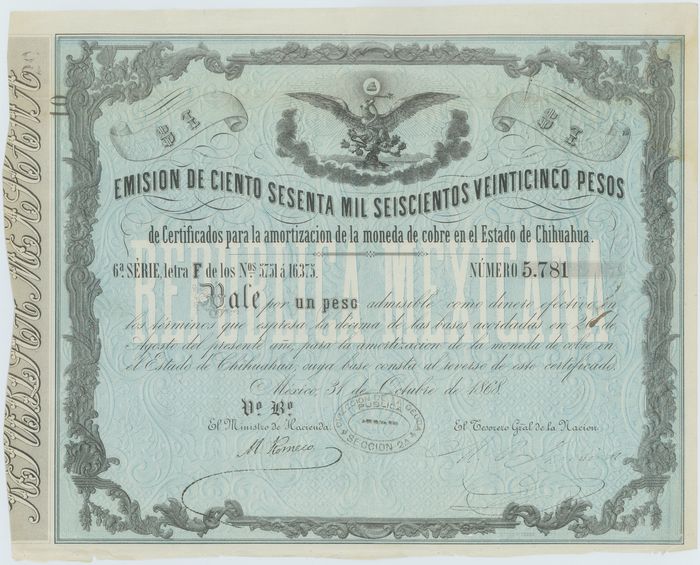
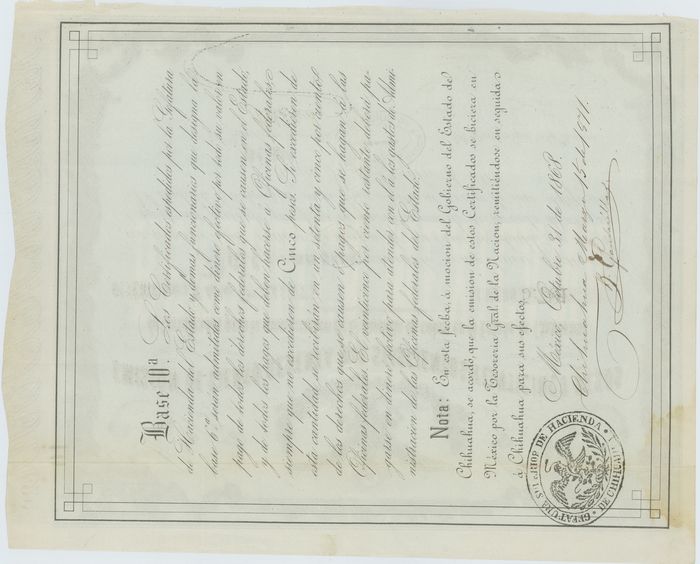
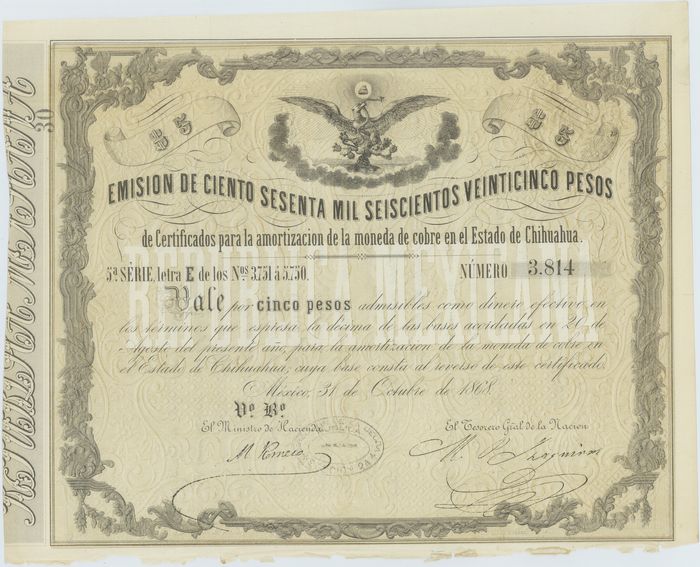


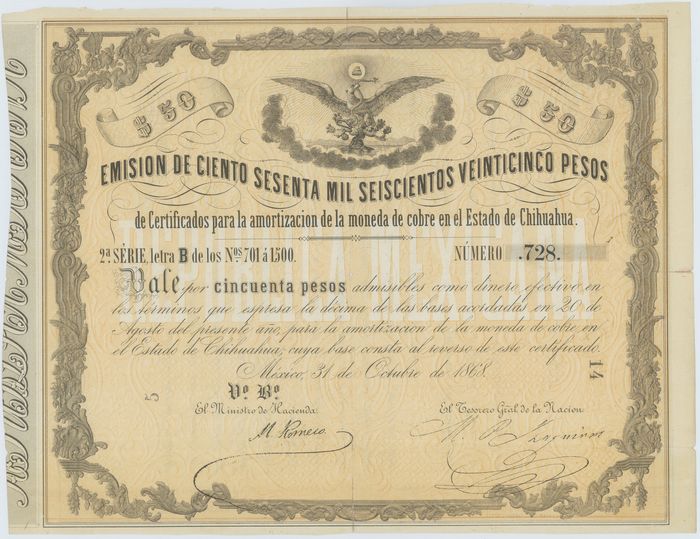
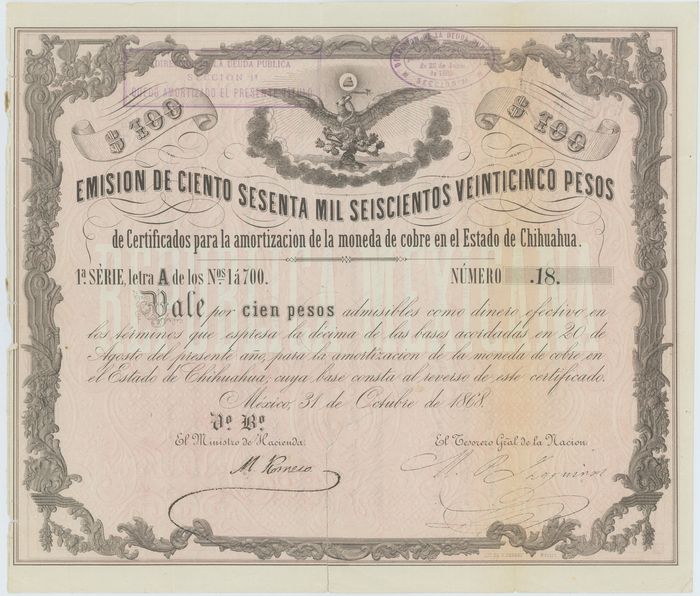
| Series | from | to | total number |
total value |
|
| $100 | 1 A | 1 | 700 | 700 | 70,000 |
| $50 | 2 B | 701 | 1500 | 800 | 40,000 |
| $20 | 3 C | 1501 | 2250 | 750 | 15.000 |
| $10 | 4 D | 2251 | 3750 | 1,500 | 15,000 |
| $5 | 5 E | 3751 | 5750 | 2,000 | 10,000 |
| $1 | 6 F | 5751 | 16375 | 10,625 | 10,625 |
| $160,625 |
They had the printed signatures of Matías Romero as Ministro de Hacienda and Manuel P. Izaguirre, as Tesorero General.
These bonds were admissible as payment for all federal duties of less than $5 or up to 75% of any duty if it exceeded that amount, the remaining quarter to be paid in hard cash. This condition (base 10a of the regulations) was printed on the reverse of the bonds.
The distribution and exchange of these bonds mainly happened in Chihuahua, even though a provision was left for some to remain in Mexico City (it is unclear if this happened or not) to help those with Chihuahua 1865-1866 cuartillas to make their exchange there. It was agreed that these bonds would be printed annually in amounts of 60,000, 40,000 and 60,000, just as the cuartillas appeared in Chihuahua. However, for different unsaid reasons, only 42,000 pesos were printed in the first batch. Very few details of this period are known. However, on 6 November 1869 an extra 15,015 pesos was approved to the usual shipment to make a quick exchange of 480,480 copper cuartillas in the hands of impatient private debters in Chihuahua who demanded their redemption in these federal bonds. Also, 42,000 pesos was said to be ready to be used in the exchange of the provisional stamps issued as temporary cash. This official notice was signed by Matías Romero.
On 7 November 1869 the Commission for the Amortisation of Copper reported and proposed that the state government act as agent for the federal government in paying the $170,000 worth of bonds that had been issuedLa Republica, 19 November 1869.
These 1868 bonds and the immediate need for cash, the abundance of cuartillas in the state of Chihuahua and other local and regional factors compelled a crucial determinant decision. Chihuahua’s government decided to devalue all state copper coinage to half of their face value on 7 November 1870. By this sole decision the 1868 bonds were null and void, now double the number of coins would be needed to satisfy the face value of the 1868 bonds. This situation got exponentially more complex when the State Legislature of Chihuahua requested, on 31 May 1871, that the last 60,000 pesos of bonds be used as a line of credit to finish a telegraphic line from Chihuahua City to Durango City. It was a desperate attempt to salvage some of the still pending debt and avoid the cuartillas coinage all together. Later on, Chihuahua’s government tried to exit that bad deal under the premise that the telegraph system was a monopoly of the Mexican government and that Chihuahua had become the only state in the nation to pay for that monopoly. Unfortunately, the deal was done, the National Treasury did not contemplate any more money for the Treasury of Chihuahua after 1871, but rather passed this sticky situation to the Ministry of Development. This was the end of anything concrete from the two treasuries to fix that loan of Juárez of 1865. A last attempt happened in 1875 to recover any of the last 60,000 pesos in bonds, but by then the telegraph line had been finished and the bonds were worthless. The Mexican Congress did not want to revive this can of worms and it was then not a big issue for debate in the Mexican Senate. The main reason was because Juárez had been dead for three years and Matías Romero was no longer the Secretary of the Tax Revenue and Public Credit Office, but, paradoxically, Manuel P. Izaguirre, one of the co-signers of the failed 1868 bonds.
Matías Romero, now reduced to a mere witness during the 1875 debates, explained that the only legal way out for these bonds could be for them to be acquired by the Government in a future conversion of the Public Debt, if that would ever happen. And indeed it did happen eight years later. However, there was still one more breath left for these bonds to be noted before that consolidation of 1885. On 30 June 1877, the Representative of the IV Electoral District for Chihuahua, the former governor José Elijio Muñoz, signed an affidavit stating that in the Chihuahua Treasury there were 144,025 pesos in these unpayable 1868 bondsAP papers, Box 3:1 “Historia Numismatica de Chihuahua”.. If this is correct, it could mean barely 16,600 pesos of these 1868 bonds in public hands. On 22 June 1885 Manuel Dublán, Secretary of the Tax Revenue and Public Credit Office, orchestrated a consolidation of Public Debt and the second section of his consolidation grouped together all official and military debts occurred by any law prior to 30 June 1882from Ricardo de León Tallavas, "The Intriguing 1868 Chihuahua Copper Coin Bonds of Exchange" in USMexNA journal, March 2023.

